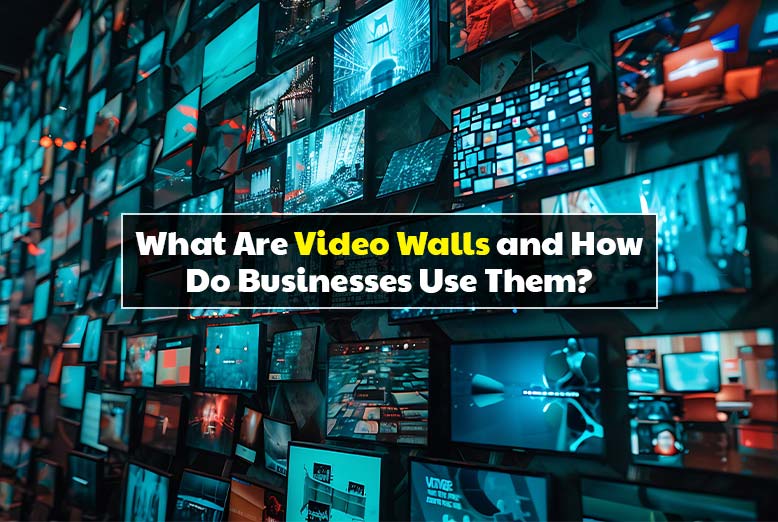Video walls have become a staple in modern business environments, providing a visually dynamic and scalable solution for displaying information and engaging audiences.
By combining multiple screens into a cohesive unit, businesses can use video walls to amplify messaging, enhance communication, and improve operational efficiency. Below, we explore video walls in detail, covering their components, functionality, and applications.
Defining Video Walls
A video wall is a collection of multiple display screens, configured to function as one unified, large display. These walls can present a single image or different content across individual panels. A video wall system is powered by a central processor that synchronizes the content for seamless output.
Components of a Video Wall System
A video wall system relies on several interconnected components to deliver its functionality:
- Display Panels: Individual screens that form the video wall. They are commonly LED, LCD, or OLED displays, each offering specific brightness, contrast, and resolution characteristics.
- Video Wall Processor: The brain of the system, distributing and aligning content across all panels.
- Control Software: Enables users to manage, schedule, and adjust the displayed content.
- Mounting Structure: Provides a sturdy framework to support the panels and ensure proper alignment.
Types of Video Walls
Video walls are categorized by the display technology they use:
- LED Video Walls: Use light-emitting diodes to provide bright, vivid images and are suitable for indoor and outdoor environments.
- LCD Video Walls: Offer high-resolution displays with excellent color accuracy, often used indoors.
- Projection-Based Video Walls: Utilize projectors to display content. While they can achieve large sizes, they are best used in controlled lighting conditions.
How Video Walls Operate
Video walls function through a combination of advanced hardware and software. The process includes:
- Content Input: Media sources, such as computers, cameras, or media players, supply the content.
- Processing: A video wall processor scales, crops, and aligns the content to fit the wall’s configuration.
- Distribution: Processed content is sent to each panel for synchronized playback.
- Display: The content is rendered on the panels, creating a seamless visual experience.
LED-powered video display walls, for instance, excel in delivering crisp and vibrant visuals, making them ideal for high-impact applications.
Advantages of Video Walls for Businesses
Video walls offer numerous benefits that cater to the demands of professional environments:
- Enhanced Visibility: The large, dynamic display captures attention and is effective for advertisements and informational purposes.
- Scalability: Panels can be added or reconfigured to adjust the display size as needed.
- Versatility: Capable of displaying a range of content, from static images to real-time data and videos.
- Durability: High-quality video walls are built for continuous operation, ensuring reliability in critical applications.
Business Applications of Video Walls
Retail
Retailers use video walls to display advertisements, showcase products, and highlight promotional campaigns. These installations enhance the shopping experience and draw customers to specific areas within the store.
Corporate Environments
In offices, video walls are integral to presentations, video conferencing, and displaying company information in reception areas. They help create a professional and engaging atmosphere for employees and visitors alike.
Control Rooms
Industries such as utilities, transportation, and emergency services utilize video walls for monitoring operations and visualizing critical data in real time. They play a key role in ensuring situational awareness and decision-making.
Entertainment and Events
From concerts to sporting events, video walls elevate the audience experience with stunning visuals. They are often used to display live feeds, replays, or sponsor advertisements in large venues.
Factors to Consider When Implementing Video Walls
Defining Purpose
Determine the primary objective of the video wall to guide decisions about technology and layout. A wall designed for advertising may prioritize brightness, while a control room display may require high resolution and reliability.
Location and Environment
Consider the location of the installation, accounting for factors such as ambient lighting, viewing angles, and the distance between the audience and the display.
Content Management
Choose a content management system that is user-friendly and supports your operational needs. Efficient scheduling and real-time updates are crucial for many applications.
Budget Planning
Evaluate the full cost of ownership, including installation, maintenance, and potential upgrades. Balancing quality with affordability is key to achieving long-term value.
Maintaining and Extending the Lifespan of Video Walls
Proper maintenance ensures the longevity and performance of video walls:
- Regular Inspections: Identify and resolve issues like dead pixels or inconsistent colors.
- Cleaning: Dust and debris can affect performance. Regular cleaning maintains image clarity and prevents overheating.
- Software Updates: Keeping the control software updated ensures access to the latest features and optimal system security.
Unlocking the Potential of Video Walls
Video walls are a powerful tool for businesses, offering unmatched versatility and impact. Whether used to captivate audiences, streamline operations, or facilitate communication, they are an investment that can transform business environments.
By carefully planning and maintaining a video wall system, businesses can maximize its benefits and deliver memorable experiences for their audiences.
Also Read: The Importance of Ethernet Cables in Home and Office Networks




















